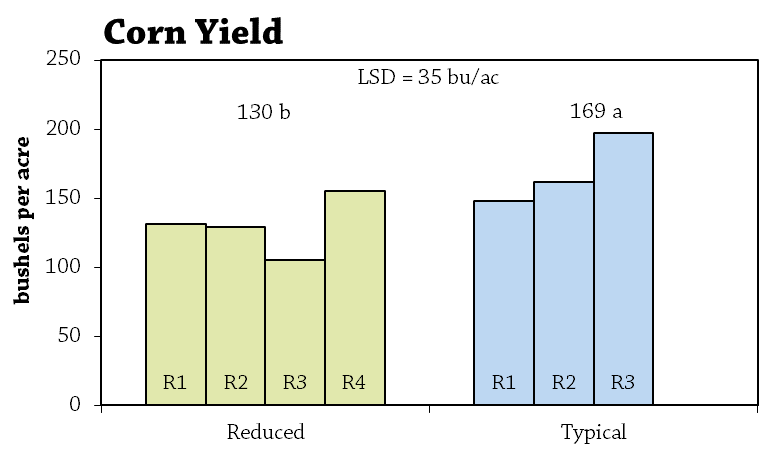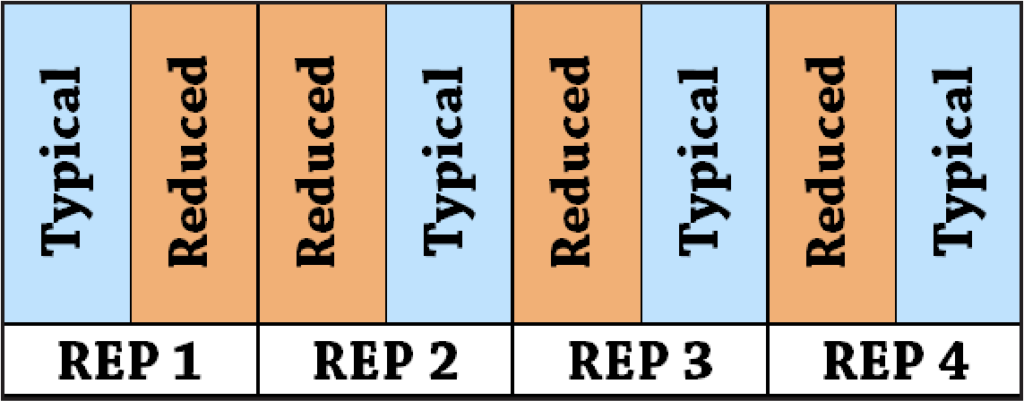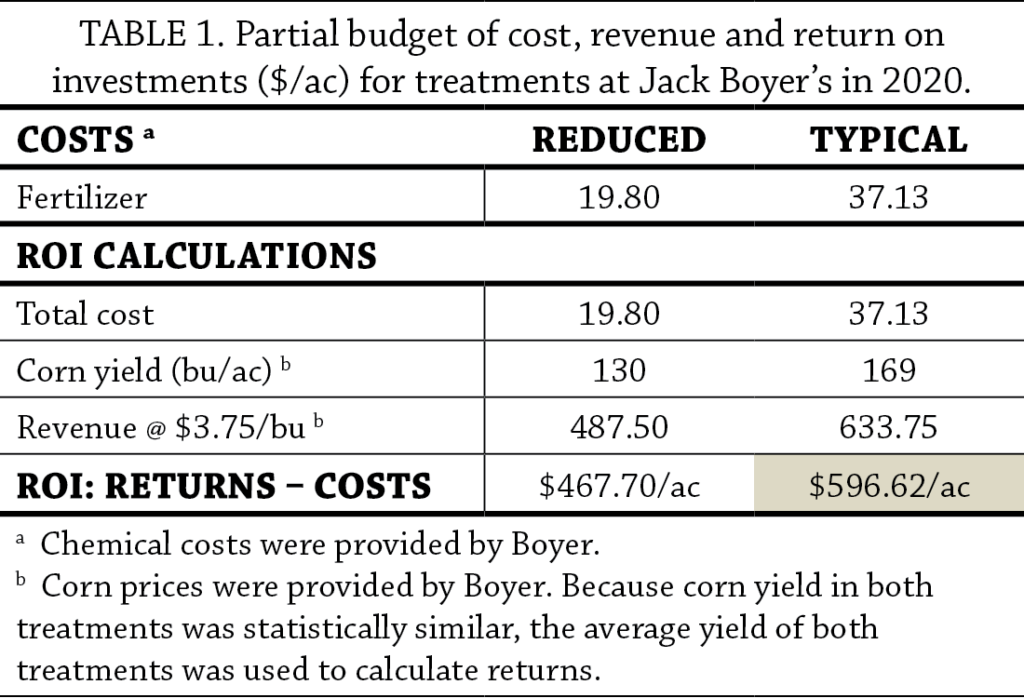This research was funded by the Walton Family Foundation.
In a Nutshell:
- Jack Boyer was curious to determine if the benefits of long-term cover cropping to soil health would allow him to reduce his nitrogen program. In a corn-soybean field with a 7-year history of cover crops, Boyer compared corn yields between strips receiving 180 lb N/ac and strips receiving 110 lb N/ac.
- Boyer hypothesized the treatments would produce similar corn yields and the return on investment would be greatest in in the reduced-rate strips.
Key Findings:
- Reducing nitrogen by 70 lb/ac reduced corn yield and cost Boyer $129/ac.
- Based on results from his 2019 trial in which he reduced nitrogen by 50 lb/ac without sacrificing yield and saved $26/ac, Boyer plans to repeat this trial a third year in 2021 to compare the reduced rates from the first two years.
Background
Jack Boyer has been curious to determine if the soil health benefits of long-term cover cropping would allow him to reduce nitrogen in the corn phase of his corn-soybean rotation. In 2019, Boyer compared yield and profitability of corn receiving his typical N rate (180 lb/ac) and corn receiving a reduced N rate (130 lb/ac).[1] He found that reducing his typical N rate by 50 lb/ac did not reduce corn yields and saved him $26/ac. To verify his 2019 results, Boyer conducted the trial again in 2020 using even less nitrogen.
Methods
Design
Boyer compared two N-rate treatments in a no-till corn field preceded by soybean:
- 180 lb N/ac (typical rate)
- 110 lb N/ac (reduced rate)
Boyer drilled cereal rye (47 lb/ac) and rapeseed (3 lb/ac) with a skip row for corn on Oct. 29, 2019. On Nov. 5, he broadcast potash (0-0-60, 101 lb/ac) and 12-40-0-10S-1Zn (29.7 lb/ac) for a total of 3.5 lb N/ac, 12 lb P/ac, 61 lb K/ac, 3 lb S/ac and 0.3 lb Zn/ac. On April 6, 2020, Boyer established treatment strips by applying anhydrous ammonia at 80 lb N/ac in the reduced-rate strips and 150 lb N/ac in the typical-rate strips. He arranged treatments in neighboring strips measuring 30 ft wide and 2,450 ft long and replicated both treatments four times (Figure A1).
Boyer planted corn into living cereal rye in all strips on Apr. 26, 2020, in 30-in. rows and at a population of 34,000 seeds/ac. One week later (May 4), Boyer applied 30 lb N/ac and 20 lb S/ac with a tank-mix of UAN(28) and 12-0-0-26S, then terminated cereal rye with a tank-mix of Roundup Powermax (44 oz/ac) and HarnessXtra (48 oz/ac).
Measurements
Boyer harvested corn and recorded yields from individual strips on Oct. 27, 2020.
Data analysis
To evaluate the effect of sulfur fertilizer on corn yield, we calculated the average yield for both treatments then used a t-test to compute the least significant difference (LSD) at the 90% confidence level. The difference between average yields is compared with the LSD to determine if the treatment yield is significantly different from the control yield. A difference greater than or equal to the LSD indicates the difference in yields is statistically significant and Boyer can expect the same results to occur 90 out of 100 times under the same conditions. A difference that is less than the LSD indicates the difference in yields is not statistically significant and the treatment had no effect.
Results and Discussion
Corn yields
Corn in Boyer’s reduced nitrogen treatment yielded significantly less than corn in his typical rate treatment (Figure 1). Yields in Boyer’s typical and reduced nitrogen treatments were 15 and 54 bu/ac lower, respectively, than the Grundy County average for 2020 (184 bu/ac).[2] Drought conditions in July and August, along with the derecho windstorm that blew through Boyer’s farm in 2020, likely influenced his results.

FIGURE 1. Corn yields at Jack Boyer’s, harvested on Oct. 27, 2020. Clustered columns represent yields of each individual strip, and the average yield is indicated above the column clusters. Because the difference between the two averages (39 bu/ac) is greater than the least significant difference (LSD = 35 bu/ac), the treatments’ yields are considered statistically different at the 90% confidence level.
Economic considerations
The return on investments (ROI) was greatest in the typical rate treatment by $129/ac (Table 1).
Conclusions and Next Steps
Reducing nitrogen to corn by 70 lb/ac in a field with a 7-year history of cereal rye cover crops reduced corn yield and resulted in an overall loss of $129/ac at Boyer’s farm. These results build on findings of a previous trial he conducted in 2019 and are important in helping him to determine a suitable nitrogen rate. In the 2019 trial, Boyer reduced nitrogen by 50 lb/ac which resulted in a $26/ac increase to ROI.[1] Boyer stated, “I have made significant reductions in my nitrogen applications and believe there are opportunities for further reduction.” To continue homing in on his ideal nitrogen rate for corn in fields with a long history of cover cropping, Boyer will repeat the trial a third year in 2021. He plans to compare the reduced rate he confirmed in the first year of the trial (130 lb N/ac) with the reduced rate in this trial (110 lb N/ac).
Appendix – Trial Design and weather Conditions

FIGURE A1. Jack Boyer’s experimental design consists of four replications of both treatments. This design allows for statistical analysis of the data.

FIGURE A2. Mean monthly temperature and rainfall and the long-term averages during the trial period at Grundy Center, the nearest weather station to Boyer’s farm (about 9 miles away).[3]
References
- Gailans, S. and J. Boyer. 2019. Does Repeated Use of a Cereal Rye Cover Crop Reduce the Need for N Fertilizer for Corn? Practical Farmers of Iowa Cooperators’ Program. https://practicalfarmers.org/research/does-repeated-use-of-a-cereal-rye-cover-crop-reduce-the-need-for-n-fertilizer-for-corn/ (accessed April 2021).
- Johanns, A. 2021. Historical Corn Yields by County in Iowa. Ag Decision Maker. Iowa State University Extension and Outreach. https://www.extension.iastate.edu/agdm/crops/html/a1-12.html (accessed April 2021).
- Iowa Environmental Mesonet. 2021. IEM “Climodat” Reports. Iowa State University Department of Agronomy. https://mesonet.agron.iastate.edu/climodat/ (accessed March 2021).


